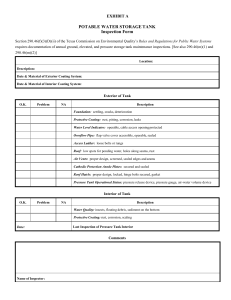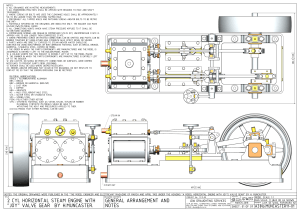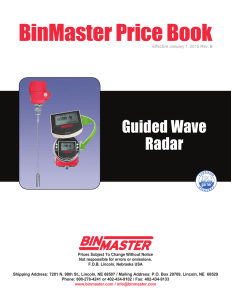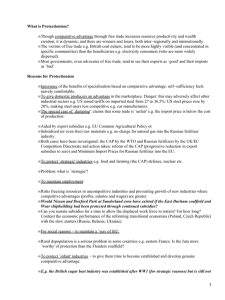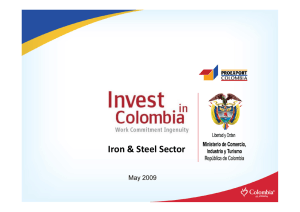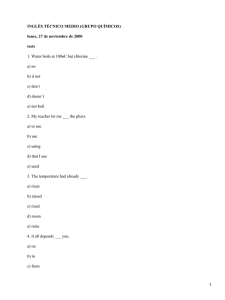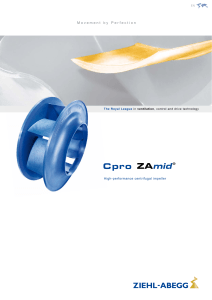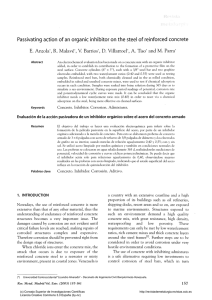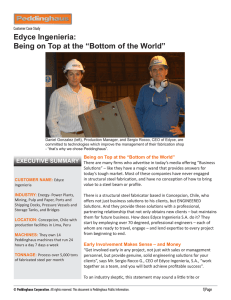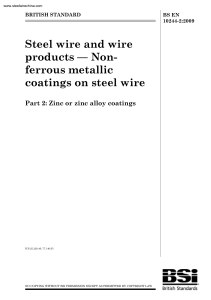EP0439989A2 BRUGAL Chromate-organic pre-treated steel for high corrosion resistance and improved paintability
Anuncio
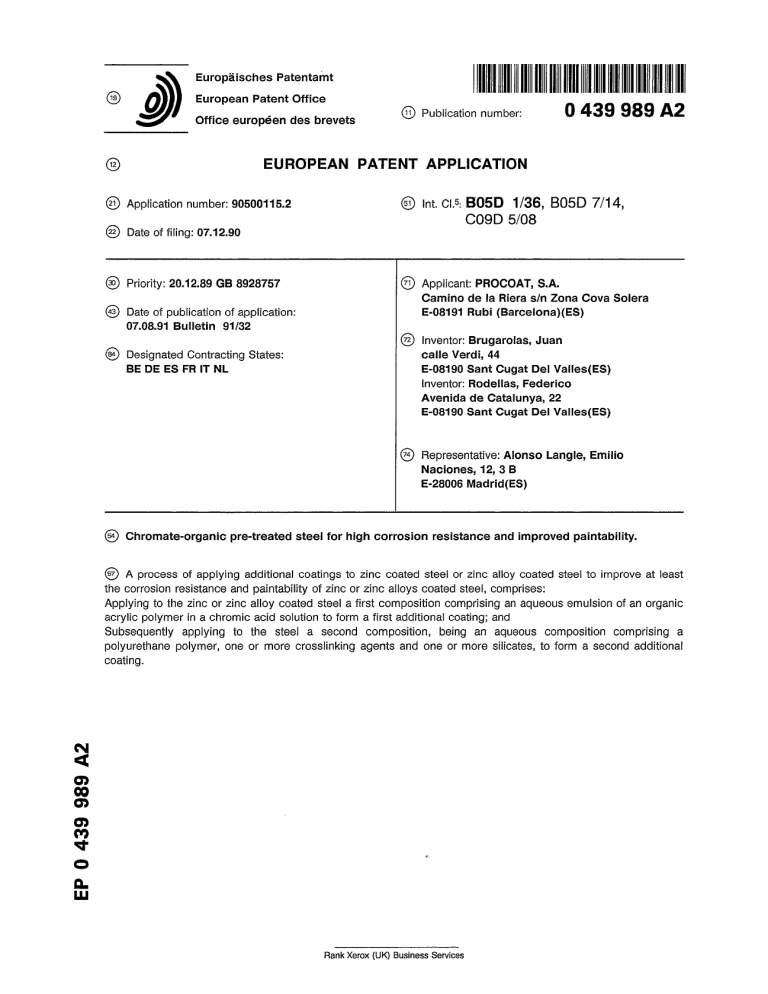
Europaisches Patentamt J European Patent Office Office europeen des brevets EUROPEAN @ Application number: 90500115.2 © Date of filing: 07.12.90 © Priority: 20.12.89 GB 8928757 © Date of publication of application: 07.08.91 Bulletin 91/32 © Designated Contracting States: BE DE ES FR IT NL Oy Publication number: PATENT 0 439 989 A2 APPLICATION © int. CIA B05D 1/36, B05D 7 / 1 4 , C09D 5 / 0 8 © Applicant: PROCOAT, S.A. Camino de la Riera s/n Zona Cova Solera E-08191 Rubi (Barcelona)(ES) @ Inventor: Brugarolas, Juan calle Verdi, 44 E-08190 Sant Cugat Del Valles(ES) Inventor: Rodellas, Federico Avenida de Catalunya, 22 E-08190 Sant Cugat Del Valles(ES) © Representative: Aionso Langle, Emilio Naciones, 12, 3 B E-28006 Madrid(ES) © Chromate-organic pre-treated steel for high corrosion resistance and improved paintability. © A process of applying additional coatings to zinc coated steel or zinc alloy coated steel to improve at least the corrosion resistance and paintability of zinc or zinc alloys coated steel, comprises: Applying to the zinc or zinc alloy coated steel a first composition comprising an aqueous emulsion of an organic acrylic polymer in a chromic acid solution to form a first additional coating; and Subsequently applying to the steel a second composition, being an aqueous composition comprising a polyurethane polymer, one or more crosslinking agents and one or more silicates, to form a second additional coating. CM < 00 0> 03 W LJJ Rank Xerox (UK) Business Services EP 0 439 989 A2 5 w 75 20 25 30 35 40 45 50 55 During last years a great deal of concern about corrosion prevention has arised, especially in the domaine of long lasting goods exposed to very detrimental atmosphere, being automobil industry an excellent example. At present time, car manufacturing industry is, slowly but progressively, replacing cold rolled steel for Zinc coated steel, because of the excellent corrosion resistance apported by Zinc to steel. In accordance, materials such as electrogalvanized, hot dip galvanized and galvannealed steel are increasing their use in the construction of car bodies. In Germany, for example, the use of such materials for this purpose is in the order of 40% of total steel sheet assembled in a car. More recently, other pre-coated steel compositions are becoming more popular, as for example ZincNickel alloy, due to its extremely high corrosion resistance. The highest anticorrosion demand from the automotive industry is consequence of the need for supplying cars with a 10 years perforating corrosion guaranty. The significant improvement in corrosion resistance of the above described materials, as compared to cold rolled steel, however it does not mean that its use by enterely satisfactory and acceptable in every situation. It is well known that Zinc developes very thick mass of oxidized products under aggresive environment, and this is responsible for the disbonding of paint coatings applied onto its surface, and furtherly increasing the rate of corrosion of the steel base. Consecuently is obvious than passivating or protecting Zinc is necessary to mantain its beneficial action onto steel, and furthermore to present good adhesion to paints. Another question which demands practical solutions is the evidence that, when pre-forming Zinc coated steel, little dust is loosen from the metal sheet, making stamping process more difficult. Passivating or protecting Zinc is a delicate process, also requiring special techniques, since too thin protective coating would be insufficient, whereas too thick layers would prevent from good welding. In the process described in U.S. Patent 4.006.041 , a phosphate-chromate plus organic resin treatment for steel, Zinc and alloy surfaces is disclosed, where passivation of metal is achieved in a single non-rinse process. This process having shown on the grounds of industrial application are revant improvement on preventing white rust formation and paintability of Zinc coated steel and more precisely hot dip galvanized strip, electrogalvanized, and Zinc-Aluminium alloys. Following U.S. Patent 4.006.041 , and introducing some new specific improvements claimed in this patent, a new two coating system for improved corrosion resistance and paintability of Zinc coated steel is described here after. In view of the demanded characteristics for special pre-coated steels by the car industry, as summarised in page 4, many attempts have been made by chemical manufactures to have an effective protection for Zinc coated steel plates. Then, a process is described in GB Patent 2096488, where a two layer system is used, being the first coating an inorganic chromate treatment and the second coating containing organic resins, sylane compounds and silica. However the complexity of the process, adhesion to further painting by electrodeposition seems to be insufficient. GB Patent 2147826 A is an improvement of such adhesion problem, and modifications are disclosed on the second coating composition, then containing epoxy resin and silica, known to be favourable for good paint adhesion. The process needing a drying-curing temperature of about 250 ° C, altering, under this condition, the required paint-bake hardenability of the steel. A further step as shown in GB Patent 2195560 A, means an improvement as decreasing curing temperature is concern. For this purpose, an especific epoxy two component resin is disclosed, as well as compositions including epoxy-polyurethane systems. Finally, the process consisting of a first coating composed by an especial chromate film and a second coating consisting of a solvent based organic film. As mentioned before, the interaction of a phospho-chromate solution in contact with an organic polymer and deposited together onto a Zinc coated surface, is responsible for an excellent improvement on the prevention of white rust fomation. This process, protected by several patents as: US 4006041 GB 1482457 RF 2248330 D 2449967 (Germany) J 1072410 (Japan) RB 821346 (Belgium) is already exploted on industrial lines, to protect materials such as, EC, HDG and Zn-AI alloy coated steel strip. Zinc coated steel pannels, treated with this process, show high corrosion resistance, such as: EP 0 439 989 A2 Salt spray test EC: 100-200 h. } HDG: 200-250 h. } Before white rust formation Zn-AI: 200-300 h. } Improved paintability, and an important reduction on friction coefficient, producing a non-galling material, are other benefits provided by the product. On the other band, weldability is not affected by the treatment, due to the extreme thin layer deposited, in the range of 0,6 gr/sq.mt. equivalent to less than 0,5 /*. In spite of the qualities shown by this process, they were not sufficient to meet the high standard w specifications required by automobil industry. Consequently a further development and improvement was necessary. A new process, as described herein, was developed aiming to fullfill all the characteristics in accordance with motor-car requirements : * High corrosion resistance * Weldability 75 * Easy formability * No Zinc dusting * Resistance to chemicals: Alkaline -Acidic * Conductivity (electropaint deposition) * No crater formation 20 * Paintability (adhesion, flexibility) * Ability to be applied on low-bake hardenable steel The new process, then consists of a two coating system applied onto the Zinc coated steel by squeezze-rollers and/or roll coater, and after low temperature drying a thin coating is obtained. The new 25 process is valid for improvement of the behaviour of different type of Zinc coated materials, such as electrozinc coated steel, hot dip galvanized, galvannealed and most especially new electro Zinc alloys as Zinc-Nickel, where highest performances are achivied. The first layer to be applied, is consisting of a phospho-chromate solution and an organic resin applied in one step, and forming an unique Zinc passivating film which acts in two ways: by inhibiting the, metal 30 surface from reacting with aggressive environment due to the presence of chromates, and sealing the surface from porosities by the organic polymer, providing a barrier to water-vapours, oxigen and other corrosive vapours. At this respect, it is important to outline that this progess differs completely from other patents, where the first coating is composed essentially of chromate film without the presence of organic compound in itself, as is claimed (claim no. 1) in GB 2195560 patent, where the first protective coating is 35 deposited via inorganic solutions, with more or less especial chromate compositions, but without the presence and benefits of introducing an organic polymer in the film. Within the same general context, the composition of this first layer may be slightly modified on its composition depending on the base material nature to be treated, whether it is EC. or HDG., for example. Thickness of deposited film is very important, too low thick film will not give sufficient corrosion 40 resistance, to high thick film would prevent from good welding and flexibility. Best general performance is obtained at thickness in the order of 0,5 /*, this corresponding to 0,8 gr./sq.mt. with a chromium content of 60-80 mg./ sq.mt. In the first layer, chromium is present in the form of hexa and trivalent, and after drying, the ratio of Cr+6/Cr+3 is between 30/70 to 5/95. Lower Cr 3 content films show a tendency to redisolution (leaching), whereas extreme high Cr 3 content 45 have unsatisfactory corrosion resistance. The conversion of chromium, which is present in the liquid composition in the form of hexavalent chromium almost exclusivelly, is performed inside the film during the drying-curing step. The presence of a resin in this composition is a key parameter for its high performance, and makes all so the difference from other granted patents in the art. The nature and characteristics of the polymer can be defined as an acrylic emulsion with an average particle size lower than 0,2 /* and a molecular weight above 1.000.000. The resin emulsion is prepared by a standard emulsion polymerization method and with standard equipment. The polymer is obtained from a selection of monomers amongst: methyl methacrylate, ethyl 55 acrylate, buthylacrilate, styrene, acrylic acid, hydroxiethyl methacrylate, glycidyl methacrylate, etc, which produce a polymer of a Glass Transition Temperature of Tg= 15-65 *C. A selective range of surfactans, anionic and no-ionic, are used in order to obtain best chemical and mechanical estability of the emulsion. Acrylic resins with some free radicals are capable of reacting and consequently crosslinking with some 5 EP 0 439 989 A2 5 10 rs 20 25 30 35 40 45 so 55 polyvalent metals. A chemical reaction of this type occurs in the deposited film during the drying-precuring stage, and it is believed that the subsequent crosslinking is responsible for the high water resistance of the polymer. From the practical and environment point of view, the process (first coating) presents the following advantages: a) The product is completely water based, with no presence of any type of solvent. Absolutely free from solvent contamination and fire risk. b) The application of this chromating coating does not include any rinsing after deposition of film. Consequently there are not chromate containning waters to decontaminate before disposal. c) Despite the presence of hexavalent chromium in the solution, the application method does not involve any high pressure impact to the metal surface, generating no-mist, neither any high temperature reaction, as other chromating processes do, and reducing considerably room ambient contamination. On the other hand, the fact of applying an organic resin at the same time, it helps also to reduce evaporation, due to the sealing effect of the polymer, This first coating of the present new process, will be applied onto the Zinc coated material, either: a) By dip or flow, followed by roll squeezing (to control film thickness) and inmediate dry-curing at 140 ° C, PMT, in EC or HDG galvanizing lines. b) By roll-coater, in separate coilcoating lines, or in EC or HDG lines themselves, if sufficient room for equipment is allowed for. ° Only requiring 140 C, PMT for curing, this permits the use of low-bake hardenable steel, a quality of steel required for automobil makers for easy forming and tools maintenance. To complete the process, the application of a second coating is required, being the objective to provide the system with extra corrosion resistance, to avoid any chromium leaching out from the coating under any conditions, whilst keeping or improving the resistance to chemical attack by acids and alkalies. The last mentioned point is of great importance, if one thinks of the use to be given to the Zinc plated steel during body-work assembly and pretreatment before painting. Since, other parts of body-work, made of other materials like steel, HDG, etc, will require a pretreatment with cleaners and phosphate solutions, it is necessary that material prepared with new process will not be affected negatively by the action of these strong chemical processes. The second coating proposed for finishing the complete process, consist of an organic polymer film, which is deposited from a water based solution. This is also a characteristic which differs from others patents, which require the use of a solvent-based composition, in order to maintain a good degree of water resistance of the complete coating system. Amongst the different type of organic polymers that were experimented for the purpose, those having a highly crosslinked structure and certain functionality, able to be blocked, were prefered. After testing, those containing a polyurethane back-bone, or its mixtures with other polymers, was selected. The use of polyurethane resins in a water based composition together with cross-linking agents, such as amine-group containing compounds and/or funtional resins, can be considered as a novelty for the purpose. The major advantage of this new type of coating is to render the final pre-coated steel surface completely resistant to chemical attack and physical degradation when in contact with alkaline cleaners and acidic phosphate solutions, as they are likely to be, when the new pre-coated steel is used, in car manufacturing, during the painting process. This is most important point, since any deterioration of the coating by chemical attack, would lead to leaching of chromates totally or partially, with negative effects as loss in corrosion resistance and contamination of cleaning solution are concerned. Any damage of the pre-coated steel sheet would negatively affect also to electro-coating deposition. The polymer is applied, as a second coating of the new process, from a colloidal acqueous dispersion, laying down a very thin film (in the order of 1 /«) onto the already deposited chromate containing polymer of the first coating. Through this technique, absolute sealing is accomplished, providing a strong barrier to permeation of oxigen and water vapours to the interphase of metal and coating. Then preventing from coating disbonding, generation of rust on metal surface is avoided and a high degree of corrosion resistance is achieved. In addition, some mineral compounds are included in the disclosed process. The mision of such compounds are to act, either as potential inhibitors and/or performing as an aid for the barrier effect. Mineral compounds were selected from a silicate group, including aluminium, calcium, magnesium silicates, and those presenting a laminar structure were prefered. Application of this second coating onto the continuos Zinc coated strip, will be done after application and drying of the formerly described first coating, by means of roll-coating method, adjusting working EP 0 439 989 A2 conditions in order to deposite a dry film of 1 n thickness; equivalent to 1 gr./sq. mt. The control of thickness of this coating is most important, since lower thickness would not provide sufficient organic polymer to produce a porous-free coating, and excesive thickness would sensibly modify standard welding characteristics for Zinc coated steel. ° Drying of this second coating, is done also at 140 C, PMT, for same reason as previous layer, to avoid hardening of the steel base metal. In brief, the new proposed chromate-organic coating for Zinc pre-coated steel, consist of: 10 COMPOSITION WATER BASED FIRST LAYER THICHNESS CURING « 0,5 /t 140 °C «1/a 140 °C Chromate-organic coating 75 WATER BASED SECOND LAYER 20 25 30 35 40 45 50 55 Organic coating + silicates The system proposed in this patent has substantial differences with previous patents. However the composition of the applied solution is specifically if a very low pH, strongly acidic and oxidant because the addition on chromic acid, phosphoric acid, where then zinc oxide is also soluble and finally a special acrylic resin compound is dispersed. According to our results those products can hardly be defined as chromate film system but as passivating film forming pretreatment. Anyhow those resin containing, first layers may belong to prior art as for example US 4.006.041. Along time however, have been improved systematically for optimal water and corrosion protection. However, those coatings alone can not be made to fulfill all the requirements of chemical stability to get through a phosphate and cataphoretic primer bath. It is the object of this new patent our finding that, if optimal film forming passivation first layers is used, the desired full set of properties is reached with a thin coat of water based polyurethane resin emulsion single component. The system gives a different chemical solution in the search of the precoated steel sheet that the industry is looking for, with the added positive features over prior art that modifications to present installations are simpler, the product has a longer pot life than the two component solvent based epoxy or epoxy-polyurethane resin based systems. Pollution to environment is very much reduced avoiding the use of solvents. In the so called chromate passivation system practically no reaction takes place in the bath between liquid and base metal. But on drying the resin, a series of reactions mainly between resin reducing compounds and polar groups and the acidic and oxidant acids, those reactions lead to a substantial destruction of chromic acid and chromates produced to metal-organic compounds on basis of chrome, mostly present as cation, valence 3, instead of chromic or chromate anion, valence 6. The result is very peculiar, is a continuous and amorphous layer of inorganic metals - organic resin complexes, with residual amounts of unreacted inorganic compounds, few of them chromates dissolved in the resin matrix. Special reference made in the patents to insoluble chromates, and chromate layers on the metal will not apply here. Because the initial chemistry is different, by stereoscan microscropoc inspection only a continuous organic and amorphous chromate complex phase can be detected on the metal, and most essentially the reaction of the film on temperature and water is fully different, even at very moderated drying temperatures below 170 °C the product properties and adhesion are excellent even if a watery emulsion is used as a second coat. As mentioned, at the beginning of the present invention, the new chromate-organic precoating process is a great improvement on the protection of steel against corrosion, through the mechanism of passivation of the Zinc on precoated steel and then enlarging to outstanding limits the life of Zinc on its sacrificial action on steel. The process of this invention has been designed to perform its benefits on almost any type of Zinc EP 0 439 989 A2 5 coated steel, including Electrogalvanized, Hot Dip Galvanized, and Zinc alloys coatings such as Zinc-Nickel and Zinc-Iron. For quite evident reasons, the final performance of the new chromate-organic coating is very much influenced by the nature of the base material itself, as concerns corrosion resistance and paint adhesion, but meaning an important improvement as compared the same base material treated with conventional anticorrosion pretreatments. As far as corrosion resistance of the new chromate-organic coating, without further painting, is concerned, the following datae may be given, and refering them to different metal base material : 10 SALT SPRAY TEST (ASTM B-117) METAL SUBSTRATE RESISTANCE TO WHITE RUST INITIAL RED R U S T 75 ELECTROGALVANIZED 20 DEPOSITION as Example 4 CHOMATEORGANIC COATING 1200-1500 h. > 3000 h, HOT DIP GALVANEED, as Example 2 30 1500-2000 li- as Example 1 ZINC-NICKEL ELECTRO- 25 600-800 h. 600-800 h. 2000-2500 h. GALVANNEALED, as Example 3 1000-1500 h. > 2000 h. 35 Improving adhesion to paints in another quality checked on Zinc coated steel treated with the process of the invention. The strong links generated between paints and the organic like pre-coated materials seem to be responsible for the high corrosion resistance showed by the complete system, (pre-coated + paint). Corrosion resistance being enhanced by the fact that interphase adhesion between metal and treatment and interlayer adhesion, prevent from water permeation and keep low electrochemical activity, and consequently 45 physical disbonding is avoided. Disbonding of the protective coating it is believed to be the cause of actual rust initiation. Because it is necessary than such a material be completely non-reactive and chemically estable against alkaline degreasers and phosphate solutions, for the reasons explained before, several tests were carried out : 50 Resistance to chemicals: 40 55 Alkaline cleaners: pH:10,5; Temperature: 55 ° C; Contact time: 2-6' UNAFFECTED Acid solutions: pH:10,5; Temperature:70 ° C; Contact time: 2' UNAFFECTED (Phosphate) Tests for adhesion and corrosion resistance have been carried out on Zinc coated steel plates which have been coated with a complete automotive painting system, according to the following process: a) ZINC COATED STEEL PLATE + 2 LAYER CHROMATE-ORGANIC EP 0 439 989 A2 10 b) CATHODIC ELECTROCOATING ALKYD - EPOXY PRIMER ALKYD - AMINE TOPCOAT Paintability Test: Above described pannels were painted with following process: Cataphoretic electrocoating Epoxi primer Alkyd top coat Salt Spray Test results are summarized below: ELECTROGALVANIZED 75 disbonding at croos-hatch (50 gr/m2) as Example 1 HOT DIP GALVANIZED (20 p) 20 > 1000 hours, without corrosion nor disbonding at cross-hatch as Example 2 2500 hours, without corrosion nor GALVANNEALED, 25 2000 hours, without corrosion nor disbonding at croos-hatch as Example 3 Zn-Ni ALLOY as Example 4 3500 hours, without corrosion nor disbonding at cross-hatch 30 Comparative Material: 35 ELECTROGALVANIZED, with phosphate 40 at cross-hatch 600 hours, 3-4 m/m wide disbonding GALVANNEALED, at croos-hatch with phosphate 45 50 55 800 hours, 2-3 m/m wide disbonding c Other accelerated weathering tests showed very good behaviour also. AJternative cycles of Salt Spray ° " ' and Humidity Cabinet under changing conditions like 40 C/98% RH., 20 C/73% RH., and 20 C/65% RH., had no detrimental effect on painted pannels after 15 weeks of continuous and cycling test. As respects formability of speciments prepared according to the invention, adhesion of the chromateorganic film showed to be excellent in bending, deep drawing and impact. Adhesion of paints is also promoted by the product of the invention. At this respect it is necessary to mention that deformation qualities are very much dependant on specific characteristics of metal substracts, in this sense, behaviour of hot dip galvanized plates are very different from electrogalavanized, and Zinc-Nickel and galvannealed have also different degrees of formabil- EP 0 439 989 A2 ity. 5 Except for electrogalvanized substrate, application of the coating of the invention onto Zinc coated steel has showed always a general improvement on fromability and paintability as compared to other metal pretreatments. In the case of electrogalvanized, application of the described chromate-organic film onto phosphate layer is recommended for best formability and impact resistance like stone chipping. The invention is illustrated by the following examples: EXAMPLE 1 Electrogalvanized steel pannels coated with 10 microns, were treated according to the invention in the following way, (after proper cleaning of the metal surface): 1st coating - A pretreatment product in accordance with U.S. Patent 4006041 and others was prepared, in two different and separate solutions. A) Organic polymer emulsion, as described previously 40-70% Cation complex (Cr. Zn) 7-1 5 % 75 Deionized water Balance B) Chromic acid (as Cr. 03) 5-25 % Inorganic acids 3-20 % Deionized water Balance 20 Both solutions were mixed together at a ratio of 2/1 and properly diluted with deionized water, so that when applied by dip onto above mentioned pannels and conveniently dryed, would provide a protective film of 0,8 + /- 0,1 gr./sq. mt., equivalent to approximately 0,5 microns: Drying was done by heating in a hot air stream at 170 ° C during 1 minute so that metal temperature reached 140 ° C. After cooling, a second coating, as proposed in general description, was applied by dip also, from a 25 diluted solution containing: Organic polymer 20-35 % Crosslinking agent 1-3 % Mineral pigments 8-20 % Deionized water Balance 30 The product being finally diluted to 10-12 % solids content, so that after application by dip, would provide a film of 1 gr./sq. mt. equivalent to 1 micron. Deposited coating was dryed at 140 ° C, Peak Metal Temperature, also. A maximum curing temperature of 140 'C was selected in order to be a suitable process to allow the use of bake hardenable steels. Which are of very common use in automotive industrie. 35 EXAMPLE 2 to 40 45 50 Clean HDG steel pannels were treated with following solutions, prepared according to previous description of the invention. Solution A) Acqueous mixture of organic polymers and a cation complex as described in Example 1: 100 % Solution B) Chromic acid (as Cr. O3): 6-14 % Inorganic acids < 3 % Metallic ions < 6 % Deionized water Balance After mixing both solutions, A and B, at a ratio of 1/1, HDG pannels were treated in the same way as Example 1. Later on, a second coating prepared according to the already described polyurethane water based lacquer was applied, and dryed under the same conditions of Example 1. EXAMPLE 3 55 The same product and application process as described in Example 1 was used to treat sample pannels of Zn-Fe alloy such as galvannealed steel. EXAMPLE 4 EP 0 439 989 A2 5 io Zinc-Nickel electrodeposited steel pannels were given a similar treatment also, with products according to the composition of the invention. Solutions were prepared as follows: A) Acrylic polymer emulsion, having a solids content of 16-32 %, and according to general description 100 % B) Chromic acid (as Cr. O3) 8-16 % Inorganic acids 5-20 % Trivalent Chromium and other cations < 4 % Deionized water Balance After mixing both solutions, pannels were treated and dryed in the same conditions as Example 1. Finally a second coating as in composition in Example 1 was applied also. EXAMPLE 5 75 20 25 30 35 40 45 50 55 Same compositions as described on Example 1 were applied on Electrogalvanized steel pannels, to which a previous phosphate pretreatment was given, using a tricationic phosphate solution. The use of a phosphate coating on Electrogalvanized steel before application of the product of the invention. Was found to be favourable to improve some of the mechanical properties of the metal substrate. The physical modification on the surface structure will furtherly improve adhesion of coatings to the steel substrate. The improvement found out in some specific adhesion tests, such as resistance to stone chipping, supports the strategy of using the new developed 2 coating system on phosphate EC steel rather than on bare EC steel. As can be seen from Examples, some differences in composition of treating solution (B) have been necessarilly made in order to obtain maximum reactivity and consequently good adhesion to different metal substrates. Various features, including optional or preferred features, of the invention may be summarized as follows: I) A double layer chromate-organic coating process to improve corrosion resistance and other characteristics, such as paintability of Zinc and Zinc alloy coated steel. The double layer process consisting of a first coating containing a special chromate acidic solution mixed and applied together with an organic polymer in emulsion state, totally or partially of acrylic nature. The second coating applied afterwords, consisting of an organic resin from a water based composition also, which nature is essentially polyurethane polymer with added crosslinking agents and silicates. 2) A double coating chromate-organic process where the first layer contains chromium ions in its hexavalent state, together or not with trivalent chromium. 3) The said 1st coating, deposited from a highly acidic solution, where besides the chromic acid content, other inorganic acids are added, being phosphoric acid one of prefered. 4) The said 1st layer containing chemical reducers also, will produce a film after drying that will content hexavalent and trivalent chromium at the ratio of 30/70 to 5/95. 5) The said 1st layer, being able to be applied industrially by roll squeezzing or roll coating, either in the galvanizing line itself or in a separate coil coating line. Drying of the coating will be made at a peak metal ° temperature between 130 C to 160 'C. 6) The nature of the organic emulsion forming part of the 1st layer and being mostly of acrylic nature, is chemically and physically estable at the pH of the solution, which is in the order of < 2. 7) A double coating chromate-organic process, where the 2nd layer is an organic polymer coating without the presence of any chromium metal ions. 8) The said 2nd layer is based on a polyurethane water based resin, together with crosslinking agents, such as amine function containing compounds or the like. 9) The said 2nd layer containing also mineral extenders and corrosion inhibitors such as silicates. 10) The said 2nd layer being applied industrially by roll route to provide a dry film of about 1 micron ° ° thick. The film being dryed at peak metal temperature of 130 C to 160 C. II) A double coating process as described in summaries 1 to 10, which coating is resistant to chemical attack by cleaners and phosphate solutions and consequently there is not leaching of chromium when steel plates treated according to the invention are processed in ordinary cleaning and pretreatment lines like those used in automotive industry. 12) A double coating process as described in summaries 1 to 11, which is enterely water based without the presence of organic solvents. EP 0 439 989 A2 13) A double coating process as described in summaries 1 to 12, of hot dip galvanized steel. 14) A double coating process as described in summaries 1 to 12, of hot dip electrogalvanized steel. 15) A double coating process as described in summaries 1 to 12, of hot dip Zinc-Iron coated steel. 16) A double coating process as described in summaries 1 to 12, of hot dip Zinc-Aluminium coated steel. 17) A double coating process as described in summaries 1 to 12, of hot dip Zinc-Nickel coated steel. 18) A double coating process as described in summaries 1 to 12, of hot dip Zinc electrocoated steel with a phosphate pretreatment. 19) A double coating process as described in summaries 1 to 12, of hot dip of any type of Zinc coated steel. 5 ?o 75 30 35 40 45 so 55 suitable for application and treatment suitable for application and treatment suitable for application and treatment suitable for application and treatment suitable for application and treatment suitable for application and treatment Claims 1. A process of applying additional coatings to zinc coated steel or zinc alloy coated steel to improve at least the corrosion resistance and paintability of Zinc or Zinc alloys coated steel, comprising: Applying to the zinc or zinc alloy coated steel a first composition comprising and aqueous emulsion of an organic acrylic polymer in a chromic acid solution to form a first additional coating; and Subsequemtly applying to the steel a second composition, being an aqueous composition comprising a polyurethane polymer, one or more crosslinking agents and one or more silicates, to form a second additional coating. 2. A process according to Claim 1, wherein the first additional coating comprises hexavalent chromium and optionally trivalent chromium. 3. A process according to Claim 1 or 2, wherein the first composition comprises, in addition to chromic acid, one or more other inorganic acids. 4. A process according to any preceding Claim, wherein the first composition comprises one ore more reducing agents and the first additional coating comprises hexavalent and trivalent chromium at a ratio in the range of 30:70 to 5:95 after curing is completed. 5. A process according to any preceding Claun, wherein the first composition is applied by means of one or more rolls or the thickness of application of the first composition is controlled by one or more rolls ana the first composition is dried at a temperature of 130 'C and 160 °C to form the first additional coating. 6. A process according to any preceding Claim, wherein the first composition as a pH of less than 2 and is physically and chemically estable if kept below 50 ° C. 7. A process accoridng to any preceding Claim, wherein the second composition is free of chromium ions. 8. A process according to any preceding Claim, wherein the second composition comprises one or more crosslinking agents. 9. A process according to any preceding Claim, wherein the second composition comprises one or more mineral extenders and one or more corrosion inhibitors. 20 25 suitable for application and treatment 10. A process according to any preceding Claim, wherein the second composition, after application to the steel, is dried at a temperature of 130 ° C to 160 ' C to form the second additional coating, the second additional coating being about 1 micron thick. 11. A process according to any preceding Claim, wherein the combination of the two additional coatings is resistant to chemical attack by cleaners and phosphate solutions, wherby chromium is not leached when the steel is processed in a conventional cleaning and pretreatment line such as used in the 10 EP 0 439 989 A2 automotive industry. 5 10 75 12. A process according to any preceding Claim, wherein both the first and second compositions are free of organic solvents. 13. A process according to any of Claims 1 to 12, wherein the coated steel is hot dip galvanized steel, or zinc coated steel. 14. A process according to any of Claims 1 to 12, wherein the coated steel is electrogalvanized steel. 15. A process according to any of claims 1 to 12 , wherein the coated steel is hot dip zinc-iron coated steel or galvannealed steel. 16. A process according to any Claims 1 to 12, wherein the coated steel is hot dip zinc-aluminium coated steel. 17. A process according to any of Claims 1 to 12, Wherein the coated steel is electrolytically zinc-nickel coated steel. 20 18. A process according to any of Claims 1 to 12, wherein the coated steel is zinc electrocoated steel with a phosphate pretreatment. 19. A process according to any of Claims 1 to 12, wherein the coated steel is any type of zinc coated steel. 25 30 35 40 45 50 55 11
